I was alarmed the first time I saw water pouring out of what looked like a sewer grate and onto the road. Now, I watch for such a sight. It is another manifestation of the enlightened engineering, design, and vision that make Paris civilized. After all, the word city comes from the same root as civilized.
This photo tells part of the story of how Paris streets are cleaned. Water under relatively low pressure is emerging from a curbside opening, of which part of the cover is on the sidewalk. These are called WOs (washing outlets) or, in French, bouches de lavage, and there are 12,000 of them in Paris. In most cases, an old piece of carpet diverts the water from the road. The idea is to keep the water in the gutter where the sidewalk curb meets the road, so it can collect assorted debris and flush it into the sewer system.
Paris is also about style, fashion, and colour. So in the photo below red and green carpets add a little panache to engineering function. Notice the larger of the two holes on the checked cover plate inset into the sidewalk. That is where workmen insert a special wrench to turn the water valve to start or stop the flow of water.
In the photo below, we see that the piece of carpet is placed so that the water can go in one direction only. Any street debris will be carried along with the flow of water. In some cases the water flows undisturbed or unaided.
Paris’s men in green often give the water a helping hand. Here, on the rue du Faubourg St Jacques, near the Boulevard Port-Royal, water is flowing along the curb while two workers keep the debris moving where the tires of parked cars obstruct the flow.
Sometimes, as we see in the image below, there is a large amount of debris—after all, the Marché Port-Royal across the street had closed a short time ago—and it is skilfully and quickly swept together by the same two workmen. The larger pieces and clumps of leaves, paper, plastic and other rubbish go into the plastic bags in the cart. The rest will be swept away.
It is all part of an ingenious cycle. In the photo below, the blue carpet directs the water towards us and it flows down.
However, when one looks just behind the bit of carpet (upstream, so to speak), we see an open grate at road level. This is where the water from further upstream would bring its debris and re-enter the system. But this is no ordinary system, and Paris is one of the few cities in the world to have it.
How does it work? Why is it there?
Most cities have only one system to supply water, which is used for everything from making coffee, cooking, and taking a shower to cleaning streets, fighting fires, and watering gardens. Whether the water needs to be potable (safe to drink) or not, it all comes from the same place and the same set of supply pipes. We want our drinking and bathing water to be treated and purified, but it is expensive and energy-inefficient to have water for street cleaning or lawn-watering treated to the same standards as potable water. Nevertheless, that is what we do in virtually every city in the world. Well, not every city. Not in Paris.
In Paris, there are two different sets of underground water pipes. Both are attached to the ceilings of the sewers. One supplies untreated water for tasks such as flushing the streets of Paris. One system and set of water pipes carries untreated (non-potable) water from the Ourcq Canal and the Seine. The water comes out at various places through WOs on the curbs and after cleaning the streets and gutters, flows into the underground sewers. This water is then treated and discharged into the Seine. There is a parallel but separate system to deliver potable water to buildings, residences, homes, stores, and restaurants.
In other words, there are two water supply systems, each serving different purposes and each having varying purity levels. There is no mixing of water from the two systems, so don’t worry when you drink Paris tap water; it is safe and I like the taste. If you want to know more about the Paris Water Supply visit Le Pavillon de l’eau (Paris has got to be one of the only cities with an entire museum devoted to its water and water supply).
The Paris dual water supply system makes good sense. But it works only because it was part of the original plan for radical modernization of the city in the mid-nineteenth century. It would be too difficult to retrofit most modern cities to the same standard.
For this, we have to thank several people: Napoleon Bonaparte, the Emperor Napoleon III, Baron Haussmann, and a brilliant engineer called Eugène Belgrand.
Napoleon Bonaparte gave Parisians their first abundant supply of flowing water when he diverted the river Ourcq into the Seine within Paris. This is now known as the Ourcq canal.
Emperor Napoleon III (shown above) decided that for his greater glory and the greater comfort, convenience, and future fame of Paris, he had to modernize it, getting rid of many narrow crooked streets, opening up wide boulevards, and providing it with up-to-date infrastructure.
Carrying out this massive job fell to Baron Haussmann, who in turn chose Eugène Belgrand, a graduate of the world-renowned École Polytechnique, as his Director of Water and Sewers of Paris. Before Belgrand, Paris had had a massive, smelly, and not very satisfactory sewer and water supply system.
Belgrand made the sewage system four times larger than it had been before and when he finished, it was a tourist attraction. He doubled the amount of daily water available to each resident, while the number of dwellings with running water grew by four times.
It was Belgrand who put in the system that separated water for human consumption and water for other purposes. At a time when most water—drinking or otherwise—was not very good, it was an astoundingly far-sighted move. The initial costs were far higher than they would have been for a single system—the system most of the rest of the world has.
The river Ourcq water became the low-pressure non-potable system for what was called “public water” and the new high-pressure water drawn from underground became the “new waters,” a potable source under enough pressure to rise up to the top of the growing number of apartment buildings. Hence the famous signs proclaiming “Eau et Gaz à Tous les Etages.”*
That decision to have a dual water system and its execution keeps Paris streets clean today. And it involves more than water gushing out from a gutter drain and men with green plastic brooms helping it and the debris along.
One morning, as I sat on the balcony of our borrowed apartment, sipping coffee made with good Paris tap water and reading a book on nineteenth-century typewriter design, I quietly gave thanks for the men below who were working to keep the city so clean. One man drove the truck, while another swept the sidewalks with a high-pressure hose. Look at the front of the truck, with its system for spraying water from the movable front-mounted spray units.
The system is not only clean, it is energy-efficient. The truck is filled with untreated water, the kind of water that most cities in the world cannot reuse. The Velib’s are not the only thing in this picture to lower the carbon footprint of Paris.
If this photo represents part of what draws you to Paris, remember that only a minute later, I took this photo.
Thank you, Napoleon Bonaparte, Napoleon III, and the often-maligned Baron who carved the future out of the past and I think did a good job of a difficult task. And thank you also, Monsieur Belgrand. I intend to learn more about you. The city we love is built on the unglamorous but essential workings of its water systems, which were far more efficient than any others. This is just one of the many pieces of infrastructure that makes Paris so livable and, might I say, loveable. Paris’s dual water system is just as much a part of the Technology of Tourism as the Eiffel Tower.
Text and photographs by Norman Ball
*For a good introduction to the changes of Napoleon III and Baron Haussmann follow this link.






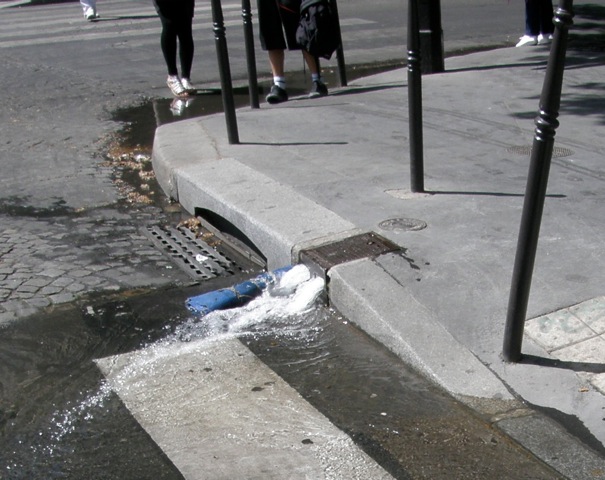
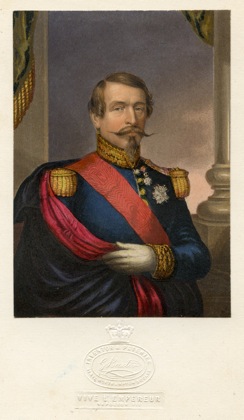







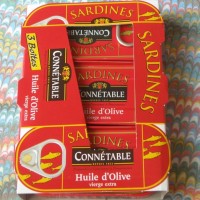


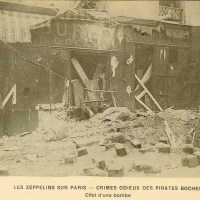


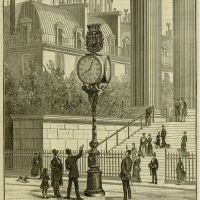









Norman and Philippa:
Eventually, you two may be forced to lead multi-day walking tours of Paris.
A wonderful explanation of the Paris waterworks. But how do they go about it in the level part of the city? Where the water would not be able to stream downwards?
It is a great compliment when a reader thinks carefully about what an author has written and then asks a question. Thank you so much and I’ll try my best with your fine question.
When in the supply pipes there is enough pressure for the water to go anywhere including uphill. Once out of the pipes and in the curb it is on its own and gravity takes it downward. Fortunately, even areas that seem level are generally not perfectly level and the water moves along under the influence of even very small changes in elevation. There is also the question of the skill and experience of the workmen who learn which drains flow unassisted to which sewer grates. Having said that we must remember this is a real-life system and there are low spots where water will collect and usually a workman helps it along with a lovely green broom. But be alert. I once had a close call. I was on the sidewalk busy taking photos and for some reason I looked down into the curb to see a nice patch of water. At the same time a car was speeding down the road towards me and hugging the curb. I jumped. The water flew up. I won that little contest.
I hope this helps and helps say thank you for all I have learned from
http://www.parijsalacarte.nl/
This system has always had me in awe. The carpet detail brings a smile to my face as I couldn’t believe it the first time I saw it but now when I see it I think it is just another of those wonderful Parisian details. A truly remarkable city! A truly remarkable blog! Thank you.
I love the sight of that water system sparkling in the sunlight on the old streets in the morning. Thank you for a most informative and enjoyable read, Norman.
I remember seeing the carpet in Paris and wondering why in the world is it there. Thanks for the informative article of human (Parisian) ingenuity!
Great post! I live in Paris and am always tickled to see the many pigeons bathing in that bubbling water, and the green man making the streets clean once again. Now I can appreciate this neat trick for more than the visuals! Merci!
I have always marveled at this street cleaning process in Paris but never knew the water used on the streets was a separate non-potable water system. I have even cleaned my shoes of inadvertently stepped on dog manure in the flowing water. Thanks for this interesting article.
I too have used the water for the same purposes; so nice that Paris supplies water whereas most cities don’t. I like your art work. It brings back memories. In many of my photos I often consciously look for reflections that create composite views (and perhaps a bit of a need to slow down and look carefully) and it is fun to look at how you have done things in my favourites, namely Espresso and Glass, Red Chair and La Seine for the wonderful sense of surrealistic humour. Hope the show in Hong Kong went well
http://www.watercolors-of-france.com/
yes, a truly fascinating and well written, and very informative article. I got quite annoyed at the beginning when week after week I saw the water flowing at the same places – and I remember vividly having said to Hero Husband that this was a remarkable waste of water – then I learned about the ‘cleaning effect’ and I shut up!!!
thank you – so well made…. 🙂
Pingback: The Paris Blog: Paris, France Expat Tips & Resources »Blog Archive » Sewers, Water, and Carpets
Haha I always wondered why there were rugs left in the same spots. It never occurred to me it was on purpose! Thanks
Pingback: The art and purpose of the colonne sèche | Parisian Fields
Hi Norman, at last I have found that you have written such a wonderful illustrated article. I have wondered from my very first September day in Paris back in 1970 as to where the water came from, if it was from the Seine or another source. I was so thrilled getting out of the hotel that first morning and finding water running along the curb and the street being washed, the smell of freshness, the azure blue September sky, the leaves changing colour–all that has stayed so clear in my memory.
Those who have not been over to the river Ourcq and have seen the boats being raised or lowered via the docks down to the seine should give themselves the pleasure and as there is a lovely park there with various film theatres and café s it is an experience.
An outstanding share! I’ve just forwarded this onto a coworker who has been doing a little research on this. And he actually bought me breakfast because I stumbled upon it for him… lol. So let me reword this…. Thanks for the meal!! But yeah, thanks for spending time to talk about this issue here on your website.
Thank you for this.
We arrived in Paris at 0530 and at our residence around 630 on a Sunday morning. The first thing we saw in Paris as we pulled up was these guys in green and the streets being washed.
Your article was very interesting and helped me understand this amazing city better.
Cheers!
thanks for this, really informative and it solved my puzzle; I too thought this was just a waste or a broken pipe…but so many? 🙂
Fascinating!But where does the water come from and why not harvest rainwater for the cleaning system?
yes where does the main water supply come from is it a dam or underground water, as I am an
AUSSIE i am very interested
Pingback: Round Pie in a Square Pan | bakingnotwriting
Hi! I hope it’s OK — I linked to your post on my latest blog post. Someone told me about the Parisian system of cleaning the streets that involved rolled up carpets and this was just the perfect explanation. Also, geekily, I’m interested in the two water systems. I know that modern cities are working to separate their sewers so that rainwater overflow doesn’t cause human waste to flow in the streets — among other things. Ironically I first got interested in this while living in Avignon one summer. In those days at least, the sewers were still OPEN — i.e., canals that ran around the city — and it smelled appalling in the heat!
I’m glad you found it interesting and thanks very much for the link. On my first trip to Paris I was intrigued by the rolled up carpets and the water coming up and being diverted by them.It seems that a lot of others share my fascination and yours.
I didn’t notice it when I was in France. I have seen similar rolls of cloth around the drains here in the SF Bay Area — more like burlap here. Not as classy.
Another mystery of Paris solved for me. Like another commentator above, since my first visit in 1970s I have been mystified. Thank you so much. Rhea T.
Thanks for the detailed explanation. I’m adding a link from blog to your post. The only thing I’d wish to see change in Paris to aide this (been living here for 4 months now) would be to have the people of Paris keep the city cleaner. The drains are clogged with cigarette butts and the streets of Paris, even in good neighborhoods are littered with dog poop as owners don’t feel obligated to pick up after their dogs. If people keep the place clean, less cleaning is required.
Reblogged this on Belgium and France by Bicycle and commented:
After multiple times of seeing water pouring down the streets, I wondered what was up. It’s this:
Thank you very much for so detailed story. I have been in Paris two years ago and cannot understand how the streets been cleaned!
I only give you one mark, water museum exists in the “sister city” of Paris, in Saint-Petersburg of Russia/
http://www.vodokanal-museum.ru/en/muzejnyj_kompleks/kratkaya_informaciya/
Hope this info is useful for your readers!
Pingback: Drains of Paris … and tales from underground | Eye on the World
Think the system of street cleaning is ingenious and the french workers do it every day. My local town of Cambridge should do something about its dirty streets, they are not even occasionally cleaned. Also, would improve London if they had a similar system.
The Paris streets are so clean in part because of the flushing system they have but equally important because they have a commitment to cleanliness which one sees every day in those who spray the streets, sweep and clean up. The Paris flushing system was built at a time of major renovation of the city under Baron Haussmann. It would be prohibitively expensive and unacceptably disruptive to do something similar in Cambridge or London. However, nothing other than perhaps institutional inertia, is stopping either city to committing to clean streets and engaging suitable labour.
Pingback: Paris v. Roma – Part II: Street Scene and Getting Around | gooddayrome
Pingback: The European beginning - Pridding
Pingback: Nggak Usah Miris dengan Drainase Kota Paris! | Selalu Bermakna
Pingback: Enjoying Europe’s Beauty | Gilman Global Experience Blog
Pingback: Getting to the Bottom of Paris History - Part-Time Parisian
Dear Norman and Philippa, I am currently writing a novel that is set in Paris and have a rather unusual question that I hope you can help me with. A body is found entangled in the moorings of a boat near Pont Neuf, but I wanted to know whether it would be possible for it to have come out of the sewer system after a period of high rainfall? I think there is some kind of pipe on the Right Bank side between Pont d’areole and Voi Georges Pompidou, but I cannot find and confirmation of this.
In addition, do you know if it would be possible to gain access to the sewer system further upstream ?
Thank you in advance for any help you may be able to offer and please let me know if you have any questions.
Kind regards,
Katherine Slee
Dear Katherine,
Your question exceeds our knowledge of the system, I’m afraid, but you might be able to find out more at the museum devoted to Paris’s water system: the Pavilion de l’Eau (http://www.eaudeparis.fr/lespace-culture/pavillon-de-leau/) in the 16th. When we went there, we found the staff very helpful and knowledgeable.
Best wishes,
Philippa and Norman
Pingback: Vespasiennes: Does a Roman Emperor Deserve This? | Parisian Fields
Can the sewerage system handle the debris and treat it in such a way not to impact on the River Seine and the end receiving waters of the English Channel and North Atlantic.. All those cigarette butts!
Totally agree about the cigarette butts. I’ve just returned from 6 nights in Paris (my first trip and stayed in the 3rd), and the first thing I noticed when I arrived was the streets were littered with cigarette butts. Maybe the cleaning system has changed since this article was written, because I did not see any gutters or paths being washed, only street cleaners sweeping the butts into the drains.
Pingback: A walk in the snow led us to Paris | Parisian Fields
Pingback: WEEKEND POST 170 | HEATHER GOESCH NUTRITION
Pingback: Can I drink the tap water in Paris (France)? - TAPP Water